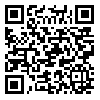قابل توجه نویسندگان محترم، مقالاتی که از تاریخ 1404/07/13 برای نشریه ارسال می شوند، شامل پرداخت هزینه بررسی نخواهند شد.
Volume 4, Issue 2 (Semi-Annual 2021)
JIC 2021, 4(2): 29-38 |
Back to browse issues page
Download citation:
BibTeX | RIS | EndNote | Medlars | ProCite | Reference Manager | RefWorks
Send citation to:



BibTeX | RIS | EndNote | Medlars | ProCite | Reference Manager | RefWorks
Send citation to:
Hoseinpour Mizab M, Mohammadzadeh M, Asadollahi A S. (2021). An Investigation of the relevancy between Turco-Mongol Mythologies and the Motif of Tree in the Demotte Shahnameh and Jami al-Tavarikh from a Cultural Semiotic Point of View. JIC. 4(2), 29-38. doi:10.52547/jic.4.2.29
URL: http://jih-tabriziau.ir/article-1-114-en.html
URL: http://jih-tabriziau.ir/article-1-114-en.html
1- Tabriz Islamic Art University
2- Tabriz Islamic Art University ,m.mohammadzadeh@tabriziau.ac.ir
3- University of Tabriz
2- Tabriz Islamic Art University ,
3- University of Tabriz
Abstract: (4831 Views)
The study and analysis of the Great Mongol Shahnama and Jami al-Tavarikh paintings has often been done with emphasis on related texts and narrations. In most of the studies and researches conducted in this field, researchers, both domestic and foreign, have paid less attention to the signs outside the narration of Shahnama and Jami al-Tavarikh. However, it seems that the signs in the text of Ferdowsi's Shahnama and Jami al-Tavarikh are very different from the visual signs of the Great Mongol Shahnama and Illustrated version of Jami al-Tavarikh according to many cases. While the Ferdowsi's Shahnama has a literary context with axial attention to the lyricism that appeared in the Iranian pretext, Jami al-Tavarikh is basically a historic source in which the pictorial language of the Ilkhanid context remained the main focus of attention. The discourse has been formed around the presence of the Mongols in Iran as a larger semiosphere, two other semiospheres, namely the Iranian semiosphere and the Turkish-Mongol semiosphere, are placed inside it. Therefore, it is thought that if the reading of the paintings of the Great Mongol Shahnama and Jami al- Tavarikh is based on the semiosphere of «Ilkhani Painting». When analyzing the visual signs, we noticed that signs outside the narrative of Ferdowsi (Iranian semiosphere) and the narrative of Jami al- Tavarikh (Ilkhani semiosphere), means that the mythical signs and Shamanistic beliefs relate to the Turkish-Mongol culture (Turkish-Mongol semiosphere). In this case, perhaps very valuable and thought-provoking results will be available to researchers and audiences in the field of Ilkhanid painting (Miniature) and so new perspectives for future researchers emerge. It is quite possible to pinpoint an Ilkhanid background to both the Demotte Shahnama and Jami al-Tavarikh. A fresh look at the Great Mongol Shahnama's book paintings is essentially based on the semiosphere approach in a way that epic narrations from the general texts of Shahnama and Jami al-Tavarikh have been considered as a non-text and filtered through the Turco-Mongol culture in an implicit way or even accepted an explicit transsemiotic mechanism and introduced in a completely varied pictorial language as a result of trans-continental influence. The aim is to study those codes related to the "Mountain" in the two stunning book paintings from the Demotte Shahnama and Jami al-Tavarikh that are entered into the realm of the Ilkhanid semiosphere through the trans-continental cultural translation.This research has been done in a descriptive-analytical way and it uses library studies. The aim of this study is fundamental and uses the methodology of semiotics and the cultural semiotics approach of Yuri Lutman. The main findings of the present study indicate that there are significant signs about the “Mountain” in the paintings of the Great Mongol Shahnama and the Jami al- Tavarikh which are related to the mythological concepts of Turkish-Mongolian culture; This results clearly suggest that the "Mountain" in the above-mentioned book paintings. Moreover, it is strongly related to the Turko-Mongol mythical attitudes and symbolically represents various concepts such as the hero's shelter, the main source of creation and fertility, the burial location of political and religious elite, the place where Tengeri is accessible to communicate, and the connection corridor to reach the other world.
Type of Study: Original Research |
Subject:
2
Received: 2020/09/14 | Accepted: 2020/10/22 | Published: 2021/02/8
Received: 2020/09/14 | Accepted: 2020/10/22 | Published: 2021/02/8
Send email to the article author
| Rights and permissions | |
 |
This work is licensed under a Creative Commons Attribution-NonCommercial 4.0 International License. |





 tabriziau.ac.ir
tabriziau.ac.ir